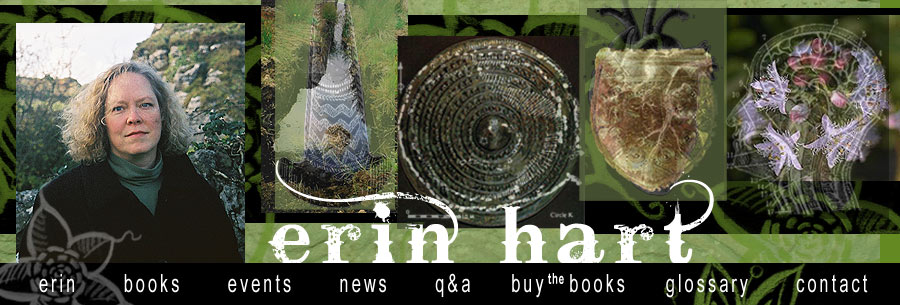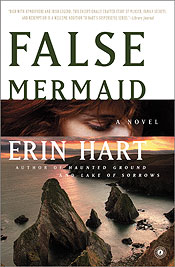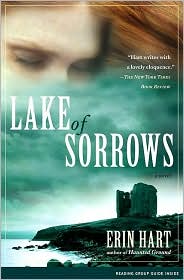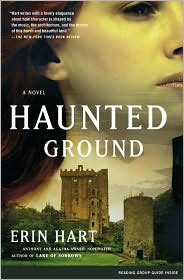My first novel, HAUNTED GROUND, was based on a true story I heard from an Irish archaeologist: In 1955 two farmers, cutting turf for their fire in the west of Ireland, discovered the perfectly preserved, severed head of a beautiful red-haired girl. From all appearances, she had been decapitated, and her remains had been buried in the bog for about 350 years. The moment I heard that story, I was convinced that it would make a smashing opening for a crime novel. Questions burst like fireworks in my head. Who was the girl? How did she come to be buried in the bog, and what crime could she have committed—why else would someone have deliberately cut off her head? And archaeology seemed a particularly apt metaphor for police work: digging through layers, searching for incomplete fragments that might help piece together a picture of the past.
In 1996, when I started writing HAUNTED GROUND, I decided it might be wise to undertake my own cursory survey of existing Irish crime writing. Feeling like an American upstart, trying to screw up my courage in order to write a story set in a country that was not my own, I wanted to see who else was writing crime fiction in and about Ireland. I scoured libraries and bookshops, expecting to be inundated.
Ireland seemed to me a setting rife with raw material: its long history of violence and bloodshed, including an underground guerilla war that has raged for centuries; a culture, like every other, replete with domestic secrets and resentments, not to mention decades of repression in the name of morality. The ruins and stones underfoot seemed ready-made set pieces for dark and moody crime fiction. And yet Ireland seemed oddly under-represented in the field. I admit that I took my survey no further—I had a book to write.
But when I was invited to this conference, I decided to approach this lingering question as a detective might: interviewing fellow writers and experts, tracking a few clues and even dreaming up a few theories of my own.
I make no pretensions to scholarship, but only note here some trends and convergences that I and others have observed.
When I say that Ireland seemed under-represented in crime writing, it’s not that crime is not present in Irish writing in general. The element of crime figures profoundly in Irish literature. One has only to look into the work of contemporary icons like Edna O’Brien and William Trevor—among others—to see that crimes, criminal psychology, and aberrant behavior are as much a part of their work as in that of any self-professed crime novelist.
Perhaps that’s where most Irish crime fiction was hiding, in amongst the general fiction. But why? Where was the writing that publishers, bookshops, and libraries might shelve under the heading “Crime Fiction”?
Rural society, low crime rate
Perhaps one reason that crime writing has been slow to take off in Ireland is that—outside of Dublin, of course—Ireland has remained, until quite recently, a very a close-knit mostly rural society. Violent crimes were committed, of course, but oftentimes there was not a lot of mystery about whodunit. Most murders, in particular, were solved very quickly, since they were rarely committed by someone unknown to the victim.
But—no doubt sharing my view about its mystique—several British writers of the early twentieth century used Ireland as a setting: Sheila Pim, who wrote what might be called traditional village mysteries, and others including Nicholas Blake (Cecil Day-Lewis, A Private Wound,1939) and Michael Innes (J.I.M. Stewart, The Case of the Journeying Boy, 1949).
I queried John-Gavin Scaggs, a professor at the University of Limerick, whose new book, Crime Fiction was published in 2004, and he observed that, “…while rural idylls are central to the fiction of Agatha Christie, the painful truth of rural existence in Ireland probably made an approach like Christie’s either unpalatable or unworkable for most Irish writers of the same period.”
However, in the early 1950s, an Irish children’s author named Eilis Dillon published three detective novels, the first of their kind to be set in Ireland. Scholars of the genre politely dismiss those stories today as “mainly interesting as vintage works.”
I was hard-pressed to find any crime writing at all between the late 1950s and the early 1980s, when Donegal writer Patrick McGinley explored some dark territory in rural Ireland. But his influence was clearly closer to the kind of fantastical, absurdist writing coming from fellow Irish authors—Flann O’Brien springs to mind—than any British crime writer.
Political violence took center stage
It’s probably not coincidence that this empty period in Irish crime fiction writing coincided with the worst of the recent so-called Troubles in the north of Ireland. Another factor in the Irish lag in crime writing might be that political violence has long overshadowed what might be termed ‘ordinary crime’ in Ireland. Novelist John Connolly points out, in trying to explain the lack of Irish crime fiction: “Many of those writers who have tried to write mystery novels have ended up using the structure to explore the situation in Northern Ireland, since there was no crime to compare with what was happening across the border.”
On the other hand, it’s important to point out that political violence has more recently given rise to variations in the crime genre in Ireland, in the work of writers like Eoin McNamee, Eugene McEldowney, among others. While not the major focus of the plots, Northern Ireland politics also flavors the writing of many others as well, including Colin Bateman, and John Brady.
A literary tradition suspicious of success
Perhaps Ireland’s late entry into crime writing had something to do with a literary tradition that was just that—literary. Crime writing has long languished in the cellar, the unacknowledged bastard child of literature, which has probably discouraged some young Irish writers from giving it a try. In a few instances, there’s been outright hostility to writers of genre fiction.
A case in point: Ken Bruen’s works are praised around the world. Bruen’s works are sharp, violent, stark, and funny—what some have called ‘Hibernian noir.’ One critic described his novels as “crime fiction on the scale of Sophoclean tragedy.” Yet in the first fifteen years of his career as a crime novelist, Bruen never had a book reviewed in the Irish newspapers. When he attended a literary festival a few years ago, a well-known poet was quoted as saying that it was a “thundering disgrace” that someone like Bruen had been invited and that he should be summarily ejected.
But literary snobbishness is hardly unique to Ireland, and doesn’t really explain the lack of crime fiction. In trying to characterize Irish crime writing, it’s important to look to the larger literary universe. Because it’s written mainly in English, Irish fiction has always been held up beside British and American fiction, its characteristics analyzed within that context.
Ireland has always enjoyed what might be termed an idiosyncratic literary tradition, if there can be such a thing. In Irish literature, as in other avenues of Irish life, there is a natural and inborn rebellious streak. James Joyce once confided to a friend: ‘It is my revolt against the English conventions, literary and otherwise, that is the main source of my talent.’
Terry Eagleton, a professor of English literature at Oxford, who has written extensively about Irish literature, puts it this way:
Unhampered by an imposing classical tradition, fiction in Ireland was free to fantasise, experiment, mix its genres, make it up as it went along. It is no accident that in Laurence Sterne’s Tristram Shandy and Joyce’s Finnegans Wake, the country produced two of the greatest anti-novels of all time, flouting the sedate protocols of English literary realism.
He says, further:
Irish writers were never as convinced as their English counterparts that there was some inherent merit in reflecting the world as it is. . . From Swift’s Gulliver’s Travels to Patrick McCabe’s Mondo Desperado!, it is non-existent worlds which enthral the Irish imagination, realms of extravagant fantasy which can be played off against the small-town tedium of the actual. A literature which includes such spiritual extravaganzas as Maria Edgeworth’s Castle Rackrent, Charles Maturin’s Melmoth the Wanderer, Sheridan Le Fanu’s Uncle Silas, Bram Stoker’s Dracula, Samuel Beckett’s Molloy and Flann O’Brien’s The Third Policeman can hardly be accused of slavishly mimicking Trollope and Thackeray. Irish fiction never bothered its head too much about well-rounded characters, narrative continuities or integrated endings…
Eagleton says, which some consider fairly critical to crime writing as a form. Instead, Irish fiction in general carried a lot from the Irish language in its genetic makeup—a love of language, color, and exaggeration, a passion for satire, riddles, and double-meanings. So it seems quite natural to postulate that the detective story—and especially the staid British detective story, which in its early structure tended to follow certain narrowly prescribed literary conventions—was not a form that would have appealed to many Irish writers.
And as the contemporary Irish crime novelist John Connolly notes (a little distastefully, it seems):
In what is regarded as ‘Golden Age’ detective fiction, the books of Christie, Sayers, etc… there is a conservatism which is a product of their time, a faith in the institutions of law and of the state…
Some would argue the point further, citing that the conventional values of detective fiction—pitting the forces of law and order against law-breakers—runs in opposition to one of the deepest undercurrents of Irish culture, which is an abiding mistrust of convention and authority. In a country racked by civil unrest and rebellion for hundreds of years, where ordinary citizens could so easily run afoul of the law by asserting their natural human rights, where outlaws and brigands enjoyed the status of popular heroes, most things do not operate by a strict black-and-white moral code.
John Connolly, again:
In Chandler, Hammett and Macdonald, there is no real sense that the police or the government will stand up for you if you are poor or vulnerable, so frequently those who act on behalf of victims come from outside the law. They are independent operators or, even when they are policemen, they are mavericks, uncomfortable with the ways in which their peers and superiors work… in Chandler and Macdonald, there is a lot of pity for the victims. Marlowe hears voices crying in the night and goes to see what’s the matter. Archer cannot ignore a plea for help. They aren’t motivated by money, or because they carry a badge and it is expected of them that they do their jobs. They act because if they do not, they are less than human. So when I came to write my own novels, I found myself naturally attracted to an American, rather than a British, tradition.
Ken Bruen also cites his influences as Chandler, James M. Cain, and James Ellroy as the writers who influenced him most, and their literary offspring could be said to include others as well:
- Colin Bateman’s wise-cracking Belfast journalist Dan Starkey, who is usually caught up in circumstances beyond his control and trying to wisecrack his way out of a jam
- Vincent Banville’s private eye John Blaine, known for taking hardboiled metaphors and machine-gun repartee to a new level.
- There’s also newcomer Declan Burke, writing about private eye Harry Rigby, whose patter is so over the top that one critic described him as ‘the gin-soaked love child of Rosalind Russell and William Powell.’
Even Irish police procedurals tend to favor the conflicted, usually hard-drinking maverick hero as well. Some examples might include Eugene McEldowney’s Belfast RUC Superintendent Cecil Megarry; Jim Lusby’s Inspector Carl McCadden series; and John Brady’s Matt Minogue, who has been called “Dublin’s answer to Maigret.”
Some cops go even further than taking an extra drink or breaking a few procedural rules, crossing into anti-hero territory: Adrian McKinty’s hero, Alexander Lawson, is an conflicted ex-cop with an active heroin habit. Ken Bruen’s policeman, Jack Taylor, is a drunken shambles, brimming with wry humor and a sense of his own mortality, on occasion just as casually amoral as the criminals he’s charged with bringing to justice.
Other currents Irish crime writing
After having traced this strong connection from hard-boiled American writers back to Ireland, you may be wondering, as I was, where are all the dames—excuse me, the women—in Irish crime fiction? What had happened to women crime writers since Eilis Dillon penned her three detective stories in the mid-fifties?
Again, there seemed to be a thirty-year gap, until Jo Bannister, from Northern Ireland, started writing a police procedural series in the 1980s. But the series was set in England. Bannister has since started a new amateur sleuth series set in Northern Ireland.
Irish born Ruth Dudley Edwards has written several books in her satirical mystery series, set in Oxford, which gleefully skewers British academia.
The last ten years or so have seen the emergence of newer female writers like Julie Jordan, who writes strong psychological suspense, and brand-new authors like former journalists Ingrid Black and Liz Allen, whose work favors the fast-paced modern thriller.
Of the writers who turned up in my initial, and admittedly cursory survey, I found Gemma O’Connor most like the kind of writer I hoped to be. She created complex characters and stories, drew connections to Irish history, and had a strong and immediate sense of place.
I will admit that some of my greatest influences were British crime novelists. (My favorite mystery writer is the great P.D. James.) But the story I felt compelled to tell was that of a red-haired girl from Ireland, and I was intrigued by the notion of telling it in my own peculiar and idiosyncratic way, blending what I knew of traditional music and folklore of Ireland with history and archaeology and modern forensics. And in so doing, I became part of another element of Irish crime fiction. The Irish diaspora has given rise to a whole sub-set of stories set in Ireland, but written by non-Irish writers:
- The popular Peter McGarr series written by Bartholomew Gill, the pen name of Mark McGarrity, who was born in the Providence, Rhode Island, and received a master’s degree in literature at Trinity College in Dublin.
- Boston-born Ann Fallon also attended Trinity and lived in Dublin for a number of years, and uses her experiences to write the adventures of a Dublin solicitor called James Fleming.
- The Sister Fidelma series, set in 7th-century Ireland, is written by Peter Tremayne, the pen name of Peter Beresford Ellis, a popular and well-known British historian whose field of study is the ancient Celts.
I hope this brief, non-exhaustive survey has give you some little insight into Irish crime writing. I have to admit that looking back now, I realize that—checkered though its history may be—there’s actually more Irish crime fiction than I imagined.
And I have a suspicion that there will be much more, though it may not take the exact shape one might expect. Because, to paraphrase Terry Eagleton’s assessment, Irish crime fiction—like Irish fiction in general—is free to fantasise, experiment, mix its genres, make it up as it goes along.
Ireland is a marvelously complex and contradictory place, where unseen worlds exist side by side with grim reality; where writers can carry on what is distinctive in the voice of Irish literature, and still maintain their own quirky and idiosyncratic styles; where there are enough stories, enough writers, and enough diverse styles to support a lively and burgeoning crime writing tradition.
Originally presented at the First European Detective Novel Meeting - Barcelona, January 2005





http://www.stories.pk i have visited to this story is very interested.
ReplyDeleteMany, many thanks for this superb essay. I'm of Irish descent, a Canadian crime novelist myself, and always in search of new writers. You've given me many wonderful leads and much to think about.
ReplyDeleteSláinte,
Liz Brady
Glad you found the piece useful -- I learned a lot in preparing for the conference in Barcelona. I was asked to present a talk about Irish crime writing, so I had to start digging! It helped answer questions I had about why there wasn't more Irish crime writing before now...
ReplyDelete